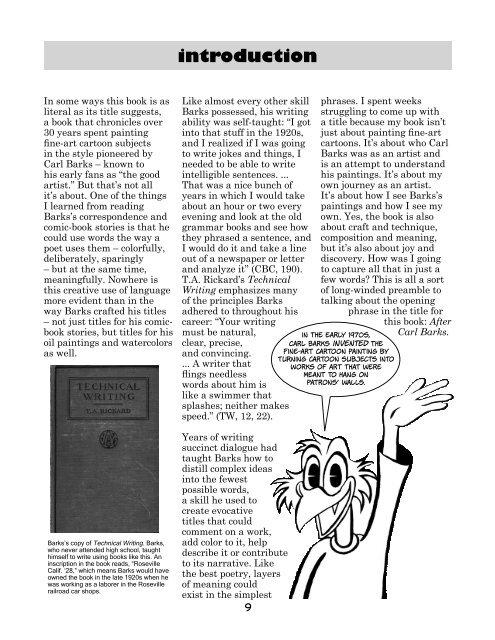Painting Fine-Art Cartoons in Oils - Enchanted Images
Painting Fine-Art Cartoons in Oils - Enchanted Images
Painting Fine-Art Cartoons in Oils - Enchanted Images
Create successful ePaper yourself
Turn your PDF publications into a flip-book with our unique Google optimized e-Paper software.
In some ways this book is as<br />
literal as its title suggests,<br />
a book that chronicles over<br />
30 years spent pa<strong>in</strong>t<strong>in</strong>g<br />
f<strong>in</strong>e-art cartoon subjects<br />
<strong>in</strong> the style pioneered by<br />
Carl Barks – known to<br />
his early fans as “the good<br />
artist.” But that’s not all<br />
it’s about. One of the th<strong>in</strong>gs<br />
I learned from read<strong>in</strong>g<br />
Barks’s correspondence and<br />
comic-book stories is that he<br />
could use words the way a<br />
poet uses them – colorfully,<br />
deliberately, spar<strong>in</strong>gly<br />
– but at the same time,<br />
mean<strong>in</strong>gfully. Nowhere is<br />
this creative use of language<br />
more evident than <strong>in</strong> the<br />
way Barks crafted his titles<br />
– not just titles for his comicbook<br />
stories, but titles for his<br />
oil pa<strong>in</strong>t<strong>in</strong>gs and watercolors<br />
as well.<br />
Barks’s copy of Technical Writ<strong>in</strong>g. Barks,<br />
who never attended high school, taught<br />
himself to write us<strong>in</strong>g books like this. An<br />
<strong>in</strong>scription <strong>in</strong> the book reads, “Roseville<br />
Calif. ‘28,” which means Barks would have<br />
owned the book <strong>in</strong> the late 1920s when he<br />
was work<strong>in</strong>g as a laborer <strong>in</strong> the Roseville<br />
railroad car shops.<br />
<strong>in</strong>troduction<br />
Like almost every other skill<br />
Barks possessed, his writ<strong>in</strong>g<br />
ability was self-taught: “I got<br />
<strong>in</strong>to that stuff <strong>in</strong> the 1920s,<br />
and I realized if I was go<strong>in</strong>g<br />
to write jokes and th<strong>in</strong>gs, I<br />
needed to be able to write<br />
<strong>in</strong>telligible sentences. ...<br />
That was a nice bunch of<br />
years <strong>in</strong> which I would take<br />
about an hour or two every<br />
even<strong>in</strong>g and look at the old<br />
grammar books and see how<br />
they phrased a sentence, and<br />
I would do it and take a l<strong>in</strong>e<br />
out of a newspaper or letter<br />
and analyze it” (CBC, 190).<br />
T.A. Rickard’s Technical<br />
Writ<strong>in</strong>g emphasizes many<br />
of the pr<strong>in</strong>ciples Barks<br />
adhered to throughout his<br />
career: “Your writ<strong>in</strong>g<br />
must be natural,<br />
clear, precise,<br />
and conv<strong>in</strong>c<strong>in</strong>g.<br />
... A writer that<br />
fl<strong>in</strong>gs needless<br />
words about him is<br />
like a swimmer that<br />
splashes; neither makes<br />
speed.” (TW, 12, 22).<br />
Years of writ<strong>in</strong>g<br />
succ<strong>in</strong>ct dialogue had<br />
taught Barks how to<br />
distill complex ideas<br />
<strong>in</strong>to the fewest<br />
possible words,<br />
a skill he used to<br />
create evocative<br />
titles that could<br />
comment on a work,<br />
add color to it, help<br />
describe it or contribute<br />
to its narrative. Like<br />
the best poetry, layers<br />
of mean<strong>in</strong>g could<br />
exist <strong>in</strong> the simplest<br />
9<br />
phrases. I spent weeks<br />
struggl<strong>in</strong>g to come up with<br />
a title because my book isn’t<br />
just about pa<strong>in</strong>t<strong>in</strong>g f<strong>in</strong>e-art<br />
cartoons. It’s about who Carl<br />
Barks was as an artist and<br />
is an attempt to understand<br />
his pa<strong>in</strong>t<strong>in</strong>gs. It’s about my<br />
own journey as an artist.<br />
It’s about how I see Barks’s<br />
pa<strong>in</strong>t<strong>in</strong>gs and how I see my<br />
own. Yes, the book is also<br />
about craft and technique,<br />
composition and mean<strong>in</strong>g,<br />
but it’s also about joy and<br />
discovery. How was I go<strong>in</strong>g<br />
to capture all that <strong>in</strong> just a<br />
few words? This is all a sort<br />
of long-w<strong>in</strong>ded preamble to<br />
talk<strong>in</strong>g about the open<strong>in</strong>g<br />
phrase <strong>in</strong> the title for<br />
this book: After<br />
<strong>in</strong> the early 1970s,<br />
Carl Barks <strong>in</strong>vented the<br />
f<strong>in</strong>e-art cartoon pa<strong>in</strong>t<strong>in</strong>g by<br />
turn<strong>in</strong>g cartoon subjects <strong>in</strong>to<br />
works of art that were<br />
meant to hang on<br />
patrons’ walls.<br />
Carl Barks.


